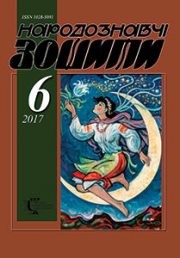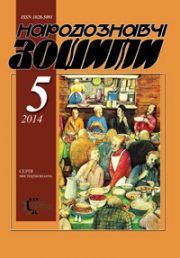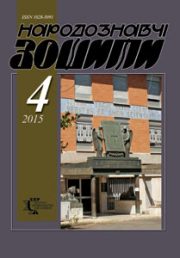The Ethnology Notebooks. 2023. № 2 (170), 442—447
UDK398.21+398.49+393.2-55
DOI https://doi.org/10.15407/nz2023.02.442
AFTERWORLD FOOD IN FOLK BELIEFS, FAIRY TALES AND RITES
KUKHARENKO Oleksandr
- ORCID ID: https://orcid.org/0000-0001-5421-1004
- Candidate of Philological Sciences, Associate Professor,
- Associate Professor of the Kharkiv State Academy of Culture,
- 4, Bursatsky Descent, 61000, Kharkiv, Ukraine,
- Contacts: e-mail: art-red@ukr.net
Abstract. The article studies the concept of «afterworld food», which is directly related to representatives of the other world, but has a direct impact on folk creativity and ritual actions. Usually, in everyday life, it was forbidden to eat such food, but during ceremonies, in certain cases, such prohibitions and taboos were removed.
Therefore, now it is impossible to definitively state what should be fed, what food should be consumed by a traveler in order to be able to get to the afterlife.
The topicality and scientific novelty of the topic are determined by the appeal in the question of the origin of afterlife food to the division of worlds into the real and the afterlife, which was overlooked by previous researchers who studied the mythological worldview of ancestors.
The object of research is the mythological worldview and its remnants, which formed fairy-tale plots and ritual actions, and the subject is afterworld food. The motive of feeding the hero of magical tales, who travels to the other world, by the witch Yaga is studied; cooking and consumption of dishes during the rite of funeral repast, which is the part of the funeral cycle; the rite of feeding ancestors on Christmas Eve, which replaced the great holiday commemorating the cult of ancestors existing in pre-Christian times. The difference in attitude towards the living and the dead, those who live in this world and the other one, is studied. It is established that in the process of sacralization of reality with the help of otherworldly energy, the driving force behind the rites of family and calendar cycles are antinomies, which also belong to two different worlds — reality and the afterlife. In his study, the researcher turns to Indian, Egyptian, Sumerian, Iranian, and ancient legends.
As a result, the author comes to conclusion that the otherworldly dish, which consists of food and drink, solid and liquid, for the Ukrainian national tradition can only be kutia, kolivo, kanun, which in their essence are one and the same dish.
Keywords: Ukrainian ritualism, funeral rites, folk tales, ritual dishes, kutia.
Received 23.12.2022
REFERENCES
- Propp, V.Ya. (2000). The historical roots of a fairy tale (P. 162). Moscow [in Russian].
- Sedakova, O.A. (2004). The Poetics of Rite. Funeral rituals of the Eastern and Southern Slavs. Moscow [in Russian].
- (1877). Proceedings of an ethnographic-statistical expedition to the Western Russian Territory, coll. P.P. Chubinsky (Vol. 4). St. Petersburg [in Russian].
- Veletskaia, N. N. (2009). Symbols of Slavic paganism. Moscow [in Russian].
- Ilarion, mytropolyt. (1994). Pre-Christian beliefs of the Ukrainian people: hist.-relig. monogr. 2nd edition. Kyiv [in Ukrainian].
- Yakovleva, O. (2005). «The Otherworld» in the ideas of ancient Ukrainians. Folk creativity and ethnography, 3, 78—85 [in Ukrainian].
- Hnatiuk, V.M. (1912). Resources for Ukrainian demonology. Etnohrafichnyi zbirnyk (Vol. 33) [in Ukrainian].
- Baiburin, A.K. (1993). Ritual in Traditional Culture: Structural and Semantic Analysis of East Slavic Rites. St. Petersburg [in Russian].
- Skurativskyi, V.T. (1996). Mermaids. Kyiv [in Ukrainian].
- Vovk, F.K. (1928). Studies in Ukrainian ethnography and anthropology. Praha [in Ukrainian].
- Borysenko, V.K. (1997). Everyday food and ritual dishes. Kholmshchyna and Podlasie: Historical and ethnographic study (Pp. 215—222). Kyiv [in Ukrainian].
- Bohatyrev, P.H. (1971). Magical actions, rites and beliefs of Transcarpathia. Questions of the theory of folk art (Pp. 167—206).Moscow [in Russian].
- SCH[elokovskaia], V. (1899). Food and drink of the Little Russian peasants with some related customs, beliefs and omens. Ethnographic review, 1—2, 266—322[in Russian].
- Kukharenko, O. (2018). Funeral Ceremony in the System of Structural-Functional Studies of Family Objectives. Paradigm of Knowledge. Multidisciplinary Scientific Journal, 2, 132—144.







